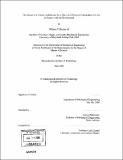The design of a control architecture for a heavy-lift precision manipulator for use in contact with the environment
Author(s)
Becker, William T. (William Theodore Leroy)
DownloadFull printable version (21.67Mb)
Other Contributors
Massachusetts Institute of Technology. Dept. of Mechanical Engineering.
Advisor
Steven Dubowsky.
Terms of use
Metadata
Show full item recordAbstract
Robotic manipulators can be used to enhance the strength and dexterity of a human user. This thesis considers the design of a controller for a heavy-lift manipulator for lifting and inserting payloads onto aircraft on the deck of a ship. The purpose of this robot is to reduce manpower requirements aboard the ship, and reduce the physical requirements for the individuals loading the payloads onto an aircraft. This particular application presents several control challenges, including structural resonances, complex interaction with the environment, high joint friction that varies over time, tight tolerances for the insertion tasks, and ship motions. This thesis builds upon previous works by Garretson [17] and DiCicco [9] by further developing an insertion control mode for intuitive human interaction with the payload of the manipulator when in contact with the environment. These control algorithms, as well as those developed in the previous work, are also validated on a laboratory manipulator. This thesis contains a detailed description of the control architecture for the heavy lift manipulator, including the insertion control mode and a position control mode for use when the manipulator is not in contact with the environment. Both architectures are validated with dynamic simulation models. (cont.) The position control response of this manipulator is shown to be improved with the implementation of friction compensation. In some joints, outputs from an adaptive friction estimator are used to make feed-forward models of friction for use during environmental contact. The position and insertion controllers are then evaluated under open-loop and human control on a laboratory manipulator.
Description
Thesis (S.M.)--Massachusetts Institute of Technology, Dept. of Mechanical Engineering, 2006. "June 2006." Includes bibliographical references (leaves 117-121).
Date issued
2006Department
Massachusetts Institute of Technology. Department of Mechanical EngineeringPublisher
Massachusetts Institute of Technology
Keywords
Mechanical Engineering.